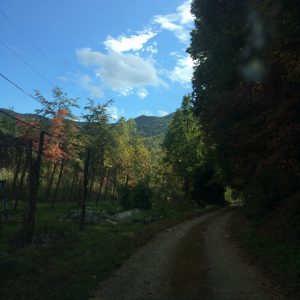This morning, I knew it was time, but I didn’t want to.
I didn’t want to run the 3.5 mile course I run on Fridays in reverse. I didn’t want to because I knew it would disrupt and disorient me. Yes, I know all of the reasons as a runner why you should reverse your familiar paths. I know that if you don’t then your shoes wear down in very specific unhealthy ways. I know if you have a nagging recurring injury that reversing your running path can reverse the negative impact on that injury and reorient any compensating behaviors you’ve accidentally taken on. I know this, but I just didn’t want to.
I knew it would mean not seeing my familiar markers, knowing exactly how much further I had to go. I knew I’d encounter the shortcut option 2/3 into my run instead of 1/3 into my run. I knew that I wouldn’t know the exact number of blocks I had to run before the next turn because I wasn’t as familiar with the path from another angle. More than anything I knew that it would mean encountering a hill that rose incrementally and steadily rather than a steep short hill where I could clearly see the end in sight.
But I knew this was good for me and so I did it reluctantly.
As I ran from the safety of the sidewalk, I realized I couldn’t see clearly what was coming towards me, but rather that I heard what was coming first. As I ran I depended on my ears rather than my sight. I could feel my nagging right hamstring relax with relief as my left hamstring took on more. And I began to realize that reversing my running path was very similar to the discipline of renewing my mind as Paul reminds us in Romans 12:
12 I appeal to you therefore, brothers and sisters, by the mercies of God, to present your bodies as a living sacrifice, holy and acceptable to God, which is your spiritual[b] worship. 2 Do not be conformed to this world, but be transformed by the renewing of your minds, so that you may discern what is the will of God—what is good and acceptable and perfect.
As someone who experienced spiritual abuse, it is so easy when I encounter something challenging to fall back into the familiar path of dogmatic, closed theology where everything has a reason and everything has an answer. It is much, much more difficult for me to reverse that pattern of thinking and lean into the disorientation of not having the familiar markers of known answers to the unexpectedness of life, but this doesn’t produce growth. This produces an unhealthy attachment to the theology that doesn’t fit and isn’t applicable at best and theology that hurts and maims at worst.
As I rounded the corner to the end of the run, I breathed a sigh of relief. I was finished. Done with reversing the path. Next week I could return to the familiar, known path. I looked down at my watch. I ran 25 seconds faster each mile than I had last week on the familiar, known path.
Maybe disruption and disorientation is what produces strength and growth as it wakes up our other senses and other muscles to something new.

